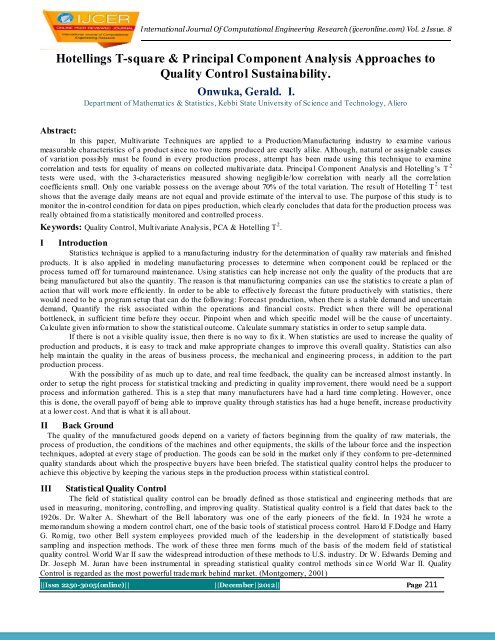ISSN: 2250-3005 - ijcer
ISSN: 2250-3005 - ijcer
ISSN: 2250-3005 - ijcer
You also want an ePaper? Increase the reach of your titles
YUMPU automatically turns print PDFs into web optimized ePapers that Google loves.
International Journal Of Computational Engineering Research (<strong>ijcer</strong>online.com) Vol. 2 Issue. 8Hotellings T-square & Principal Component Analysis Approaches toQuality Control Sustainability.Onwuka, Gerald. I.Department of Mathematics & Statistics, Kebbi State University of Science and Technology, AlieroAbstract:In this paper, Multivariate Techniques are applied to a Production/Manufacturing industry to examine variousmeasurable characteristics of a product since no two items produced are exactly alike. Although, natural or assignable causesof variation possibly must be found in every production process, attempt has been made using this technique to examinecorrelation and tests for equality of means on collected multivariate data. Principal Component Analysis and Hotelling‟s T 2tests were used, with the 3-characteristics measured showing negligible/low correlation with nearly all the correlationcoefficients small. Only one variable possess on the average about 70% of the total variation. The result of Hotelling T 2 testshows that the average daily means are not equal and provide estimate of the interval to use. The purpose of this study is tomonitor the in-control condition for data on pipes production, which clearly concludes that data for the production process wasreally obtained from a statistically monitored and controlled process.Keywords: Quality Control, Multivariate Analysis, PCA & Hotelling T 2 .I IntroductionStatistics technique is applied to a manufacturing industry for the determination of quality raw materials and finishedproducts. It is also applied in modeling manufacturing processes to determine when component could be replaced or theprocess turned off for turnaround maintenance. Using statistics can help increase not only the quality of the products that arebeing manufactured but also the quantity. The reason is that manufacturing companies can use the statistics to create a plan ofaction that will work more efficiently. In order to be able to effectively forecast the future productively with statistics, therewould need to be a program setup that can do the following: Forecast production, when there is a stable demand and uncertaindemand, Quantify the risk associated within the operations and financial costs. Predict when there will be operationalbottleneck, in sufficient time before they occur. Pinpoint when and which specific model will be the cause of uncertainty.Calculate given information to show the statistical outcome. Calculate summary statistics in order to setup sample data.If there is not a visible quality issue, then there is no way to fix it. When statistics are used to increase the quality ofproduction and products, it is easy to track and make appropriate changes to improve this overall quality. Statistics can alsohelp maintain the quality in the areas of business process, the mechanical and engineering process, in addition to the partproduction process.With the possibility of as much up to date, and real time feedback, the quality can be increased almost instantly. Inorder to setup the right process for statistical tracking and predicting in quality improvement, there would need be a supportprocess and information gathered. This is a step that many manufacturers have had a hard time completing. However, oncethis is done, the overall payoff of being able to improve quality through statistics has had a huge benefit, increase productivityat a lower cost. And that is what it is all about.II Back GroundThe quality of the manufactured goods depend on a variety of factors beginning from the quality of raw materials, theprocess of production, the conditions of the machines and other equipments, the skills of the labour force and the inspectiontechniques, adopted at every stage of production. The goods can be sold in the market only if they conform to pre -determinedquality standards about which the prospective buyers have been briefed. The statistical quality control helps the producer toachieve this objective by keeping the various steps in the production process within statistical control.III Statistical Quality ControlThe field of statistical quality control can be broadly defined as those statistical and engineering methods that areused in measuring, monitoring, controlling, and improving quality. Statistical quality control is a field that dates back to the1920s. Dr. Walter A. Shewhart of the Bell laboratory was one of the early pioneers of the field. In 1924 he wrote amemorandum showing a modern control chart, one of the basic tools of statistical process control. Harold F.Dodge and HarryG. Romig, two other Bell system employees provided much of the leadership in the development of statistically basedsampling and inspection methods. The work of these three men forms much of the basis of the modern field of statisticalquality control. World War II saw the widespread introduction of these methods to U.S. industry. Dr W. Edwards Deming andDr. Joseph M. Juran have been instrumental in spreading statistical quality control methods sin ce World War II. QualityControl is regarded as the most powerful trademark behind market. (Montgomery, 2001)||Issn <strong>2250</strong>-<strong>3005</strong>(online)|| ||December||2012|| Page 211
















